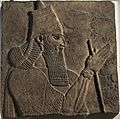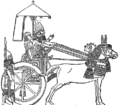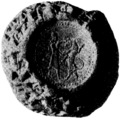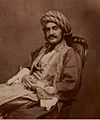Neo-Assyrian Empire facts for kids
Quick facts for kids
Neo-Assyrian Empire
|
|||||||||||||||||||
|---|---|---|---|---|---|---|---|---|---|---|---|---|---|---|---|---|---|---|---|
| 911 BC–609 BC | |||||||||||||||||||
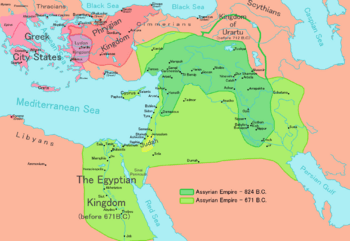
Map of the Neo-Assyrian Empire in 824 BC (dark green) and in its apex in 671 BC (light green) under King Esarhaddon
|
|||||||||||||||||||
| Capital | Aššur (911 BC) Kalhu (879 BC) Dur-Sharrukin (706 BC) Nineveh (705 BC) Harran (612 BC) |
||||||||||||||||||
| Common languages | Akkadian (official) Aramaic (official) Sumerian (declining) Hittite Hurrian Phoenician Egyptian |
||||||||||||||||||
| Religion | Polytheism | ||||||||||||||||||
| Government | Monarchy | ||||||||||||||||||
| King | |||||||||||||||||||
|
• 911–891 BC
|
Adad-nirari II (first) | ||||||||||||||||||
|
• 612–609 BC
|
Ashur-uballit II (last) | ||||||||||||||||||
| Historical era | Iron Age | ||||||||||||||||||
|
• Reign of Adad-nirari II
|
911 BC | ||||||||||||||||||
|
• Battle of Nineveh
|
612 BC | ||||||||||||||||||
|
• Siege of Harran
|
609 BC | ||||||||||||||||||
| Area | |||||||||||||||||||
| 670 BC | 1,400,000 km2 (540,000 sq mi) | ||||||||||||||||||
|
|||||||||||||||||||
| Today part of | Iraq Syria Israel Turkey Egypt Sudan Saudi Arabia Jordan Iran Kuwait Lebanon Cyprus Palestine |
||||||||||||||||||
The Neo-Assyrian Empire was an empire in Mesopotamia during the Iron Age. During its existence from 911-609 BC, it was the largest empire in the world up to that time, doing many early techniques of imperialism which became normal in later empires. It was, according to many historians, the first real empire in history. It also pioneered many tactics such as arming themselves with iron weapons and employing advanced, effective military tactics.
After the conquests of Adad-nirari II in the 900s BC, the Neo-Assyrian Empire became the successor to the Old Assyrian Empire (2025-1378 BC) and the Middle Assyrian Empire (1365-934 BC), and dominated the Ancient Near East, the East Mediterranean, Asia Minor, the Caucasus, and parts of both the Arabian Peninsula and North Africa, conquering and lasting longer than their rivals, such as Babylonia, Elam, Persia, Urartu, Lydia, the Medes, Phrygia, the Cimmerians, Israel, Judah, Phoenicia, the Neo-Babylonian Empire, Canaan, the Kushite Empire, and Ancient Egypt.
The empire began to fall in 631 BC when Ashurbanipal died, and many civil wars, allowing Cyaxares, King of Persia and the Medes, to form an alliance with Nabopolassar, Ruler of Babylonia and the Cimmerians and invade Assyria. Assyria allied itself with Egypt, but they both fell at the Fall of Harran in 609 BC. The second Siege of Harran finally ended Assyria. However, even today there are still Assyrian people living in Iran, Iraq, and elsewhere.
History
911-859 BC
The campaigns of Adad-nirari II allowed Assyria to become a great power after overthrowing the Twenty-fifth Dynasty of Egypt and conquering Elam, Urartu, Media, Persia, Mannea, Gutium, Phoenicia/Canaan, Arabia, Israel, Judah, Philistia, Edom, Moab, Samarra, Cilicia, Cyprus, Chaldea, Nabatea, Commagene, Dilmun, Shutu, and the Neo-Hittites, as well as removing the Nubians, Kushites, and Ethiopians from Egypt and forcing a tribute from Phrygia and others. In addition, he and his successors conquered areas previously only somewhat under Assyrian control, and deporting Arameans and Hurrians. He then twice attacked and defeated Shamash-mudammiq of Babylonia and again to his successor, Nabu-shuma-ukin I.
The next three kings were also equally aggressive. Tukulti-Ninurta II in 891 BC succeeded Adad-nirari II and expanded into Asia Minor and the Zagros Mountains, before being succeeded by Ashurnasirpal II in 883 BC, who recovered much of the territory lost after the fall of the Middle Assyrian Empire in 1100 BC, and ended an uprising caused by the Lullibi and Gutian people. He and his successor and son, Shalmaneser III were known for their ruthlessness and policies of deportation, as well as their love of art. Ashurnasirpal II also moved the capital to Kalhu.
859-783 BC
Annual campaigns under Shalmaneser III allowed both the capital to be turned into an army camp and the occupation of important rivals. Babylon was occupied and Babylonia came under Assyrian rule, however the Battle of Qarqar in 853 BC against Aramean states ended in a stalemate. In 849 BC Carchemesh was occupied and by 842 BC Damascus was forced to pay tribute, as well as Tyre and Sidon, then part of Phoenicia in 841 BC.
A civil war then began in 828 BC as his eldest son Ashur-nadin-aplu and 27 cities rebelled against the governors of Assyria, allowing Babylonia, the Medes, Manneans, Arameans, Neo-Hittites, and Persians to largely recapture their land and Urartu to exert its influence in the region. Second son of Ashurnasirpal Shamshi-Adad V finally ended the Civil War in 824 BC, the same year as his father's death, and spent almost the entire rest of his reign trying to re-conquer lost land before his death in 811 BC, when succeeded by his wife, Queen Sammuramat and then his son Adad-nirari III in 806 BC.
Adad-nirari III was an aggressive Monarch, invading The Levant, subjugating the Arameans, Phoenicians, Philistines, Israelites, Neo-Hittites and Edomites, reinforcing tribute upon Damascus, invading Persia and subjugating the Persians, Medes, and Manneans up to the Caspian Sea, and conquering the Chaldean and Sutu tribes of southern Mesopotamia.
783-745 BC
After the death of Adad-nirari III in 783 BC there was a period of stagnation, when Shalmaneser IV led only minor victories against Urartu during the Battle of Til Barsip, Arameans and Neo-Hittites before his own death in 773 BC. Another set of civil wars beset the reigns of Ashur-dan III, who reigned from 772-754 BC and Ashur-nirari IV from 754-745 BC, with uprisings in Ashur, Arrapkha, and Guzana, the failure to invade Aram-Naharaim or Babylonia, an outbreak in plague, and a solar eclipse, seen as a bad omen. Ashur-nirari IV was deposed by general Pulu, who changed his name upon becoming King to Tiglath-Pileser III in 745 BC, bringing back Assyria.
744-727 BC
As soon as Tiglath-Pileser took the throne in 744, Assyria had both civil war and pestilence threatening it, while a war with Uratru was lost. However, Tiglath Pileser III made enormous changes to the structure of Assyria, improving its security and efficiency. The provinces
Images for kids
-
Assyrian borders and campaigns under Ashur-dan II (r.934–912 BC), Adad-nirari II (r.911–891 BC) and Tukulti-Ninurta II (r.890–884 BC)
-
Annals of Tukulti-Ninurta II (r.890–884 BC), recounting one of his campaigns
-
Stele of Ashurnasirpal II (r.883–859 BC)
-
Stele of Shamshi-Adad V (r.824–811 BC)
-
Stele of Bel-harran-beli-usur, a palace herald, made in the reign of Shalmaneser IV (r.783–773 BC)
-
Partial relief depicting Tiglath-Pileser III (r.745–727 BC)
-
20th-century illustration of Tiglath-Pileser III's capture of Damascus
-
20th-century reconstruction of Sargon II's palace at Dur-Sharrukin
-
Line-drawing of a relief depicting Sennacherib (r.705–681 BC) on campaign in a chariot
-
Esarhaddon (r.681–669 BC), as depicted in his victory stele
-
20th-century illustration of the Assyrians capturing Memphis, the Egyptian capital, during the Assyrian conquest of Egypt
-
Relief depicting Ashurbanipal (r.669–631 BC) in a chariot, armed with a bow
-
Impression of a seal possibly belonging to the eunuch usurper Sin-shumu-lishir (r.626 BC)
-
Fall of Nineveh (1829) by John Martin
-
20th-century illustration of the Battle of Carchemish
-
Line-drawing of a Neo-Assyrian relief showing soldiers forming a phalanx
-
Neo-Assyrian cuneiform tablet from the Library of Ashurbanipal listing synonyms
-
Line drawing of an Assyrian lion weight once belonging to the king Shalmaneser V (r.727–722 BC). The inscriptions on the weight are in both Akkadian (on the body) and Aramaic (on the base).
-
Reconstruction of the Library of Ashurbanipal
-
Relief depicting the gardens of Ashurbanipal in Nineveh (left) with a color reconstruction (right). As can be seen on the right side of the relief, the garden featured sophisticated irrigation aqueducts.
-
Egyptian papyrus from c. 500 BC containing the Story of Ahikar
-
The Defeat of Sennacherib by Peter Paul Rubens
-
1861 illustration by Eugène Flandin of excavations of the ruins of Dur-Sharrukin
-
Portrait of the Assyrian archaeologist Hormuzd Rassam c. 1854
-
Chart depicting the ideological translatio imperii, i.e. supposed transfer of the right to universal rule, from the Neo-Assyrian Empire to (rival) early modern states claiming the same right
See also
 In Spanish: Imperio neoasirio para niños
In Spanish: Imperio neoasirio para niños









